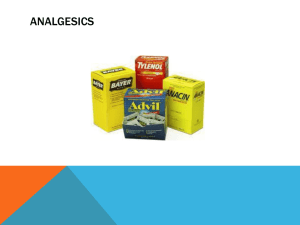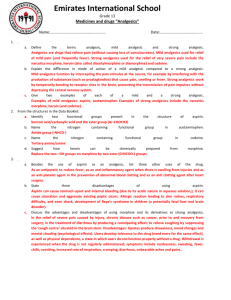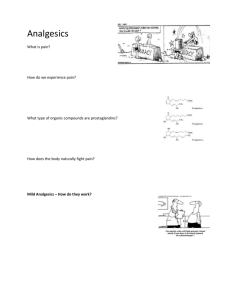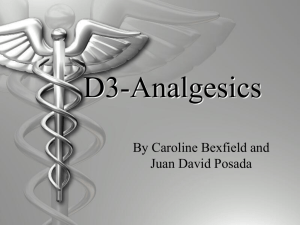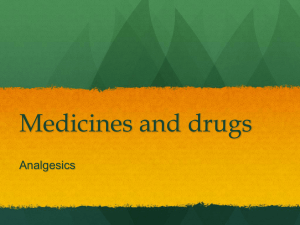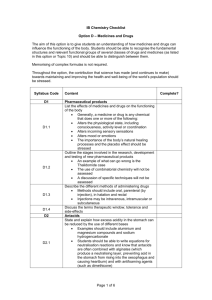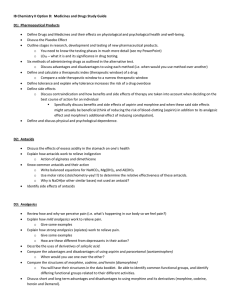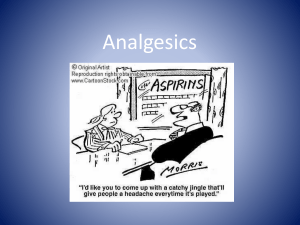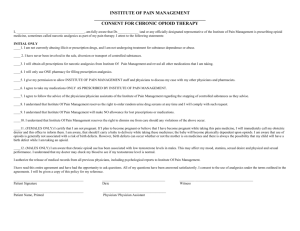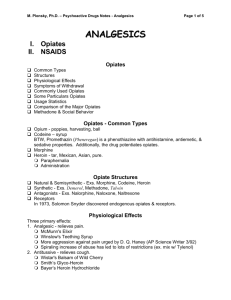Analgesics are medicines that relieve pain
advertisement
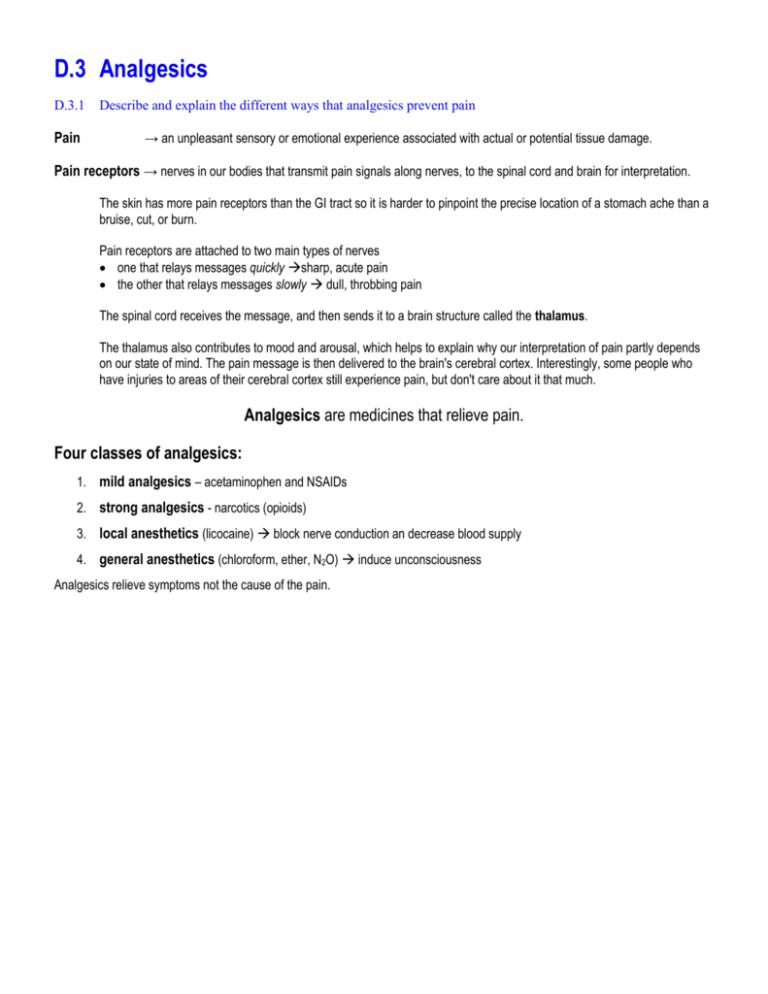
D.3 Analgesics D.3.1 Pain Describe and explain the different ways that analgesics prevent pain → an unpleasant sensory or emotional experience associated with actual or potential tissue damage. Pain receptors → nerves in our bodies that transmit pain signals along nerves, to the spinal cord and brain for interpretation. The skin has more pain receptors than the GI tract so it is harder to pinpoint the precise location of a stomach ache than a bruise, cut, or burn. Pain receptors are attached to two main types of nerves one that relays messages quickly sharp, acute pain the other that relays messages slowly dull, throbbing pain The spinal cord receives the message, and then sends it to a brain structure called the thalamus. The thalamus also contributes to mood and arousal, which helps to explain why our interpretation of pain partly depends on our state of mind. The pain message is then delivered to the brain's cerebral cortex. Interestingly, some people who have injuries to areas of their cerebral cortex still experience pain, but don't care about it that much. Analgesics are medicines that relieve pain. Four classes of analgesics: 1. mild analgesics – acetaminophen and NSAIDs 2. strong analgesics - narcotics (opioids) 3. local anesthetics (licocaine) block nerve conduction an decrease blood supply 4. general anesthetics (chloroform, ether, N2O) induce unconsciousness Analgesics relieve symptoms not the cause of the pain. B.3.2 Describe the use of derivatives of salicylic acid as mild analgesics and compare the advantages and disadvantages of using aspirin and paracetamol (acetaminophen) Mild Analgesics 1. Acetaminophen → relieves pain by elevating the pain threshold; more pain needed before it is felt. → antipyretic 2. NSAIDs, non-steroidal anti-inflammatory drugs Corticol Steroids (Cortisone, Prednisone) – steroids used to reduce inflammation NSAIDs (ASA, ibuprofen) – reduce production of prostaglandins and the inflammatory response COX inhibitors – bind to cyclooxygenase enzyme to prevent creation of prostaglandins. Prostaglandins – chemicals, similar to hormones, which trigger physiological changes like increased temperature and dilation of blood vessels. If prostaglandin production is blocked, fever and inflammation is reduced. Prostaglandins also help the stomach lining to resist gastric acid which is why aspirin can cause stomach irritation and bleeding in some people Antipyretic → reduces fever Antipyretics affect the temperature-regulating centre of the brain (hypothalamus) Antiplatelet agent = blood thinner prevents abnormal blood clotting Prostaglandins cause platelets to stick together to form clots Table 1. A comparison of aspirin and paracetamol (acetominophen). Topic D.3.2. Anti-pyretic Anti-inflammatory Pros Best pain relief Acetylsalicylic acid √ √ Blood thiner (ASA) Aspirin Acecaminophen Tylenol √ No stomach irritation Fewer interactions Fewer side effects Cons Reye’s syndrome in children Increases stomach bleeding - worsened by alcohol Potential damage to liver Reduced pain relief Same pain relief as ibuprofen B.3.3 Compare the structures of morphine, codeine, and diamorphine (heroin, a semi-synthetic opiate). Strong Analgesics - Narcotic analgesics (opioids) are all derived from opium. Natural Painkillers – endorphins and enkaphalins bind to neuro-receptors of the brain responsible for runner’s high, rugby high, temporary loss of pain for severe injury produced through acupunture and chiropractic adjustments Opioids − morphine, heroin, codeine, Demerol, Methadone alter pain messages by influencing brain chemistry strong pain relief of severe pain heroin is 6x stronger than morphine and 36x stronger than codeine ALL tend to be addictive Narcotic = “sleep inducing” Alkaloid → nitrogen-containing drug or medicine Opium alkaloids All have effects on the body similar to morphine All have the same basic structure phenyl ring 2 x 6-carbon rings, one has a double bond 6-membered ring including a nitrogen attached to a methyl group 5-membered ring with an oxygen Each drug has different functional groups: Morphine – two hydroxyl (-OH) groups Codeine - hydroxyl (-OH) and methyl group attached to oxygen Heroin – two acetyl (CH3COO) groups - diester B.3.4 Discuss the advantages and disadvantages of using morphine and its derivatives as strong analgesics. Table 2. Summary of the effects of narcotics Usual short-term effects sedation and stupor; pain relief euphoria impaired functioning and coordination temporary impotence Typical long-term effects loss of appetite malnutrition and constipation sterility reduced tension, worry and fear withdrawal, illness, loss of job, crime reduced coughing reflex diversion of energy and money occasional death from overdose risk of infection from shared needles (HIV, Hepatitis)
